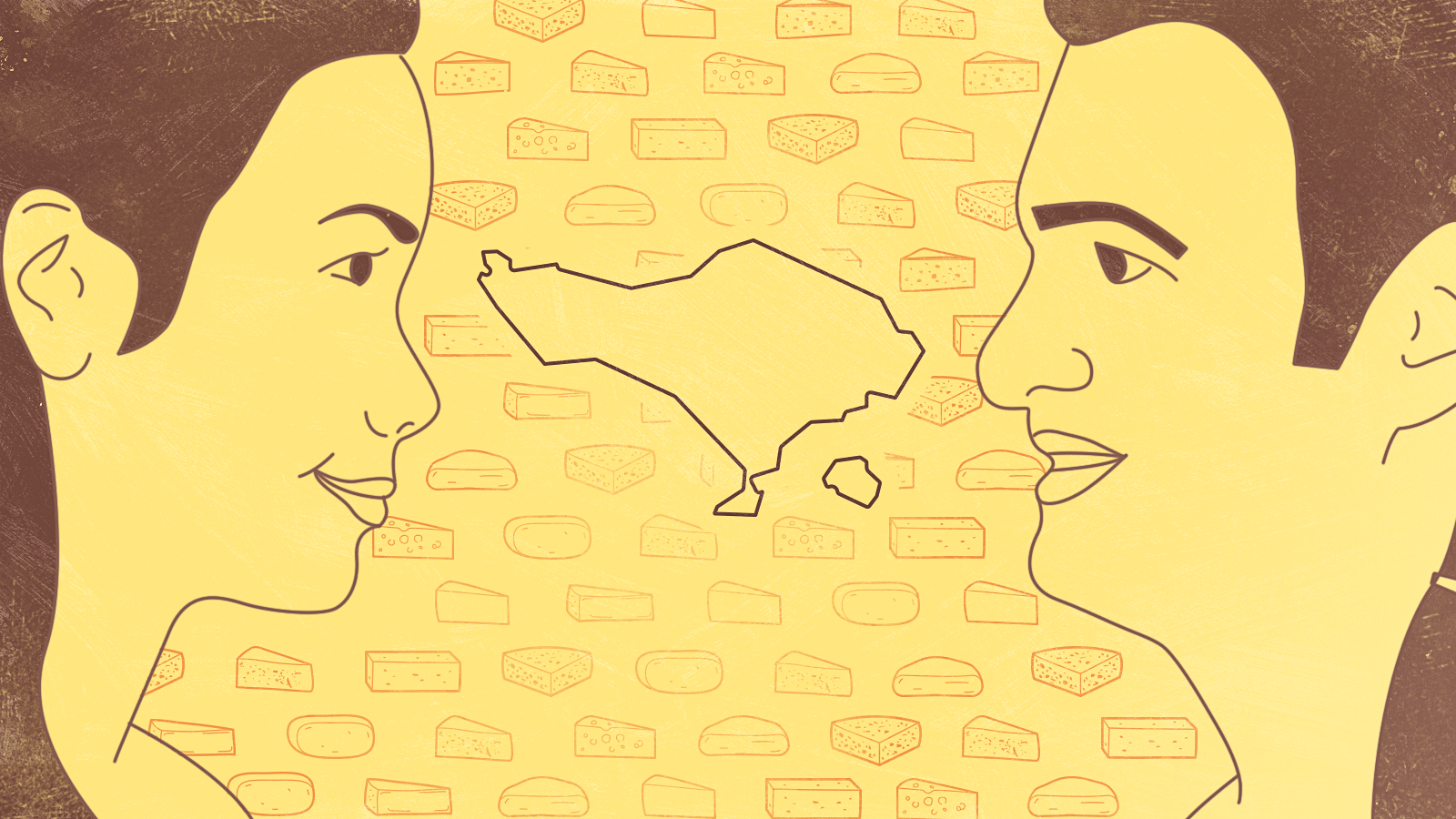Getting cheese in Bali isn’t easy. There aren’t many choices and what’s readily available is either processed… well, crap — or mere slivers of the good stuff, made unreasonably expensive thanks to drastic import markups.
The couple behind cheesemaking company Pasti Enak is hell bent on changing that. Odit Hartati, 41, and Chris Hayashi, 46, dropped everything they were doing to study the science of cheesemaking and aging, as well as the business skills needed to get their cheese brand O-Dairy up and running. It now churns out more than 20 cheese varieties.
For them, it was a “natural business decision.” There was an unmet demand for affordable parmesan, cheddar, and other all-natural cheeses — especially from the island’s hungry tourist and expat population. But, Hartati and Hayashi did not go in cheesemaking based on business alone.
Hayashi is the kind of guy who will pack up the car with his wife and toddler, driving from Colorado to Los Angeles, and then on to the Arctic Ocean, “just to check it out.” Hartati is the kind of woman who will chart the course, make it happen, and “go along with his crazy ideas.”
“Within 17 years, we’ve probably been apart five days,” says Hayashi.
He’s Hawaiian and she’s local Balinese. Hartati’s childhood home is just a stone’s throw away from the couple’s cheese-making facility in Klungkung, East Bali. The couple welcomed us into their home, onto their terrace overlooking Mount Agung, to chat cheese and nibble on some of their creations. They also told us that they prefer to keep a low profile, so we’ve only got one photograph of them. From behind.
Cheese: the final frontier
So why cheese?
Over glasses of homemade flower-infused water, Hayashi explains to us that it was the difficulty of cheesemaking that attracted them to it in the first place. The couple had already been in the habit of producing foodstuff from their kitchen, until Hayashi tried his hand at homemade cheese and realized it required a totally different level of knowledge and skill:
“So, it’s kind of like the last frontier for me, as like, the culinary arts of how to do this.”
They started making cheese in 2003 as a hobby, but were quickly frustrated.
“Our cheese was horrible. The taste, the texture. The color, the consistency, everything. We didn’t have the right setup or knowledge. We were just trying to do it from books. This was really before anything was on the internet. The only thing that was good was our camembert and cambozola, but that even made me more confused because I was like how come this works, but the cheddar doesn’t.”
At that time, the couple had a farm in a quiet spot in East Bali some 40 kilometers from Bali’s tourist hub of Kuta. The farm had a rotation of rice, sweet potatoes, and other assorted crops. It was a nice life, but not a particularly challenging one.
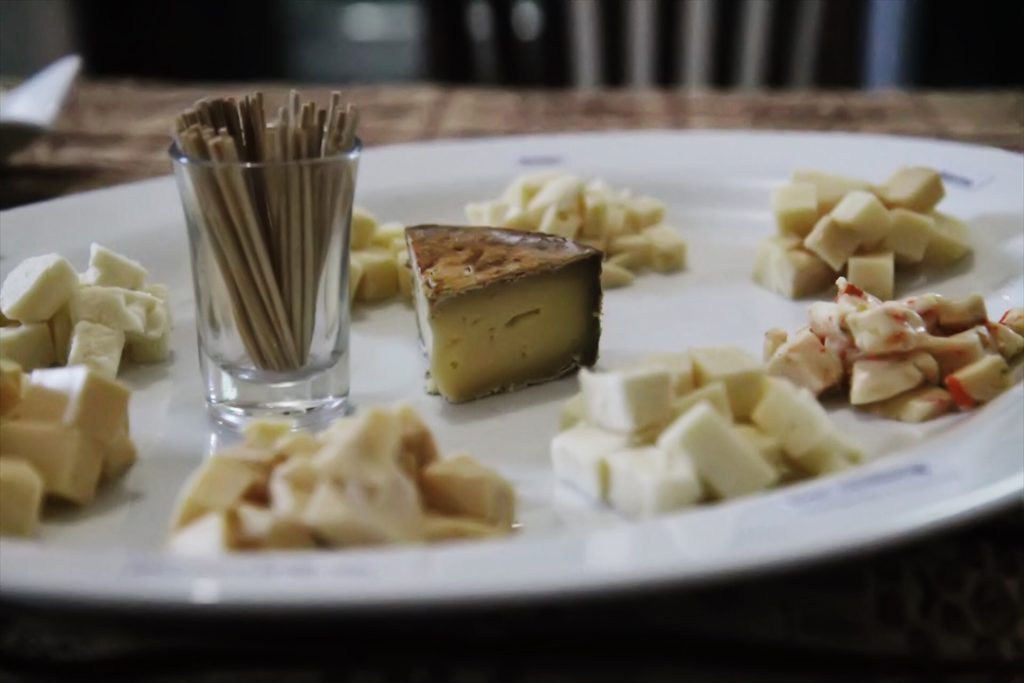
And so, they sold the farm and went back to university in the United States to enroll in a bachelor’s program in dairy sciences. “We had the choice between doing like one of these really nice ‘come and stay in our chateau in France and learn cheesemaking from an old lady for a few weeks’ things, which we were really tempted to do.
“And then we were like, no, we really need to do this right, so we challenged ourselves and submitted our transcripts and got some credits.”
We asked the couple about the school, but Hayashi refused to reveal any further details. “I prefer not to say which university because it took us a lot of time to figure out which the best one was and we spent some money actually traveling around and seeing other universities so I’d like the people who try to copy us to at least spend that 15 grand to do that too.”
The facility
After finishing up their courses, it took them about another year to put together a full-on operations manual demonstrating their facility’s compliance with international health and hygiene standards. It came out to be about 2,500 pages. Single-spaced.
Then came the day Hayashi and Hartarti had to present this manual to Indonesia’s Food & Drug Monitoring Agency (BPOM), which is in charge of granting licenses in the country’s dairy industry.
With BPOM, companies must get 100 percent before they can get their final license, but that process usually takes about two years, says Hayashi.
“When BPOM came, Odit was like ‘we’ve gone overboard with this, there’s no way they’re going to need to know all of this stuff.’ And then, they were here for about 11 hours and went through it page by page. When they left, she [the official] was like ‘Thank you!’, because we got a 100 [that same day]. They said that it’s unheard of.”
Setting up a state-of-the-art facility that meets the many government-mandated requirements to obtain Makanan Dalam certification, (needed for domestic companies in larger scale food production) wasn’t a walk in the park, but the couple has pulled it off. Their current facility has been operational since last July.
The couple now has a whole complex complete with comfortable living quarters, a green-roof in the works, office space, and facilities to produce cheese, yogurt, and ice cream. It’s in Klungkung, on a lot of land that Hartati’s father bought when she was in high school. You can see her old town from the Pasti Enak complex’s terrace.
The couple essentially ended up building the whole complex with their bare hands, originally hiring a series of contractors, only to ultimately dismantle it and rebuild it their way, to get the quality they wanted.
Unfortunately, we couldn’t get into the facility to see the actual production up close. The facility is virtually sealed off, closed to the public for an important reason: “Because it’s the dairy industry, you can kill people,” explains Hayashi. He explains that they run a clean room environment that requires people to wear “bunny suits” on the premises. Potential new employees have to undergo strict medical testing before getting hired.
A wheel of cheese is nothing like a ‘piece of cake’
From sourcing the milk to the actual cheese production, cheesemaking is not for the disorganized or impatient. “It’s hardcore. It’s not cooking,” says Hayashi.
Truckloads of fresh milk from Java get pumped into the building. The milk has to come from the next island over: “You can’t have milk cows in Bali. The genetics of the Balinese cow is a specific line and they’re trying to keep the genetics pure, so you’re not allowed to bring milking cows or any other genetic type of cows onto the island. So there are a few people who have them, but yeah, you can’t get cow milk here, legally.”
Finding a stable supply of good, quality milk has taken time, with the couple going through a number of suppliers: 11, to be exact. They had to cut ties with 8 of them. “They try to add water. They try to add melamine. They try to add powdered milk. They try to add everything under the sun. That’s one of the reasons we have to lab test before they are allowed to pump it into the building.”
After milk gets pumped into the building, it gets molded and an initial test is run. From there, Hayashi explains: “We’ll go down there by three in the morning and we’ll pasteurize the milk and cool the milk and make cheese.”
After pasteurizing the milk, they’ll run another test, to make sure they did the job right. Then the process continues: “Generally with making cheese, you take the milk and turn it into its own filter and then you let what’s called the whey drain out of the filter. And that’s cheese.”
“Then the art comes in of how you handle that to turn it into different types of cheese. We age our cheeses for up to two years depending on the variety. You have to flip the cheese and do all kinds of stuff to it to treat it and promote the life that’s growing in it and make sure it doesn’t turn in to some nasty cheese.”
Pasti Enak has their own cheese caves in the facility, because different cheeses require different types of environmental conditions to “do their thing,” says Hayashi.
Before the cheese is sold, each batch gets tested. If it passes, they take a sample, reserve it, and then sell it.
Making cheese goes way beyond following recipes to a T, something which the couple really struggled with in the beginning. “I thought that you just follow a recipe and it’s not that. It’s something else. You really have to know what you’re doing.
“It’s like cooking is dealing with death. You cut the vegetables and then you cook them. You kill the animal and then you cook it. But with natural cheesemaking, you’re taking something that’s not really living and you’re putting bacteria into it and creating life and like a child, you have to take care of it. If you treat it badly, you’ll get a nasty piece of cheese.”
“And then if you treat it right, you will often get great cheeses. But even if you treat all of the cheese the same, every once in awhile, there’ll be a few pieces of cheese that are really really special. You’ll go back in your notes and go how the hell did I do this?
“It’s the exact same as this piece of cheese over here. They should be the same. They came from the same milk. They were made on the same day. They have the same treatment. Except that one is off the scale good and that one is good.
“Before I send the cheese out, almost always if I’m there, I’ll cut a piece off and every once in awhile I’ll find a special one and I’ll put it aside. Put my name on it and I’ll put it in the cave. Don’t touch that stuff, it’s for me and Odit.”
The cheeses
With about 24 cheese varieties at the moment (and more to come in development), Pasti Enak has the range of it all: the stinky crumbly stuff, the fresh creamy stuff, the hard salty stuff, and even the spicy stuff.
Cheddar and haloumi are the best sellers, along with the pungent Matahari (Indonesian for sun), a sake-washed Trappist-style soft cheese that we’d say can be quite polarizing — meaning you kinda gotta be into stinky cheese to enjoy this one. Named for its yellowish color, the Matahari is an experience worth having, especially for the epicure; you will find the inside of the wheel much milder. The sake used during production ferments into vinegar on the rind, so there’s no residual alcohol content and you’re left with nothing but potent flavor.
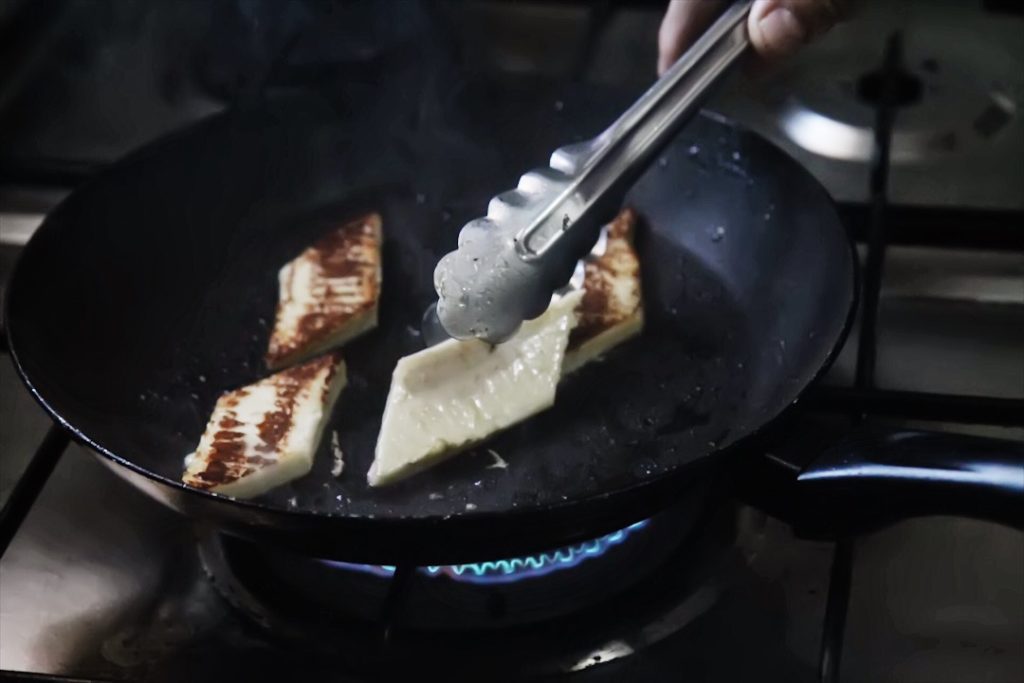
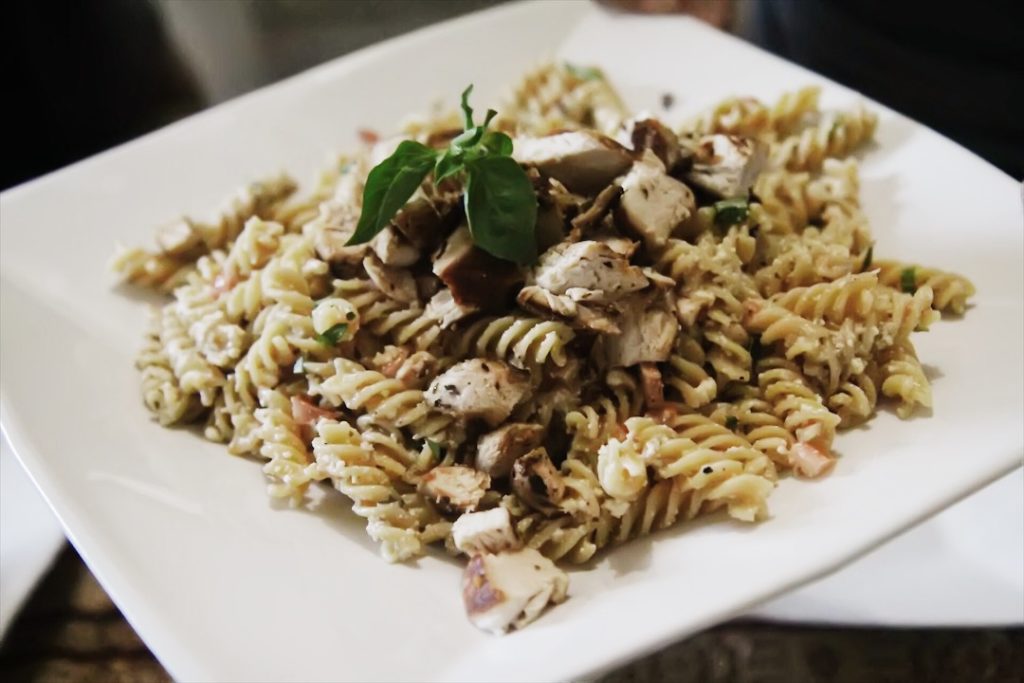
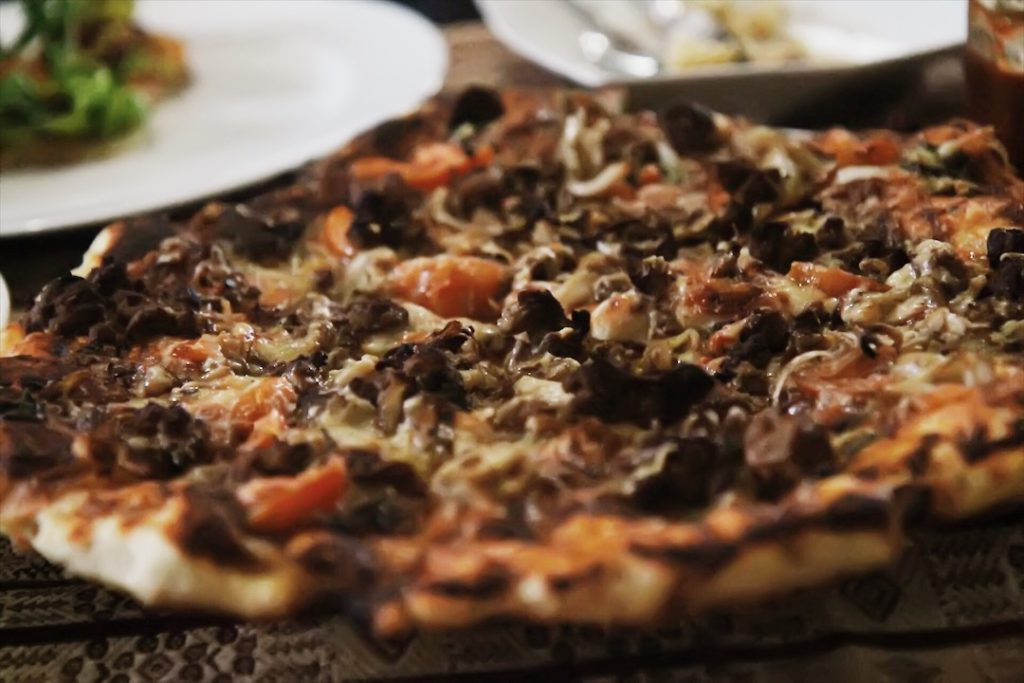
But for Hartati and Hayashi, asking them to name their favorite Pasti Enak cheese is like asking them to name their favorite child — only, choosing their favorite kid is easier, since they only have one: a five-year-old daughter, Tara Odelia.
Instead, Hayashi demonstrates for us that it’s more about choosing and applying the right cheese according to what you’re making.
This is where Hayashi’s background as a cook becomes evident. Moving naturally around his kitchen while continuing to speak to us, in about 30 minutes he whipped up an entire meal: bruschetta with arugula, bell pepper, and grilled haloumi. Chicken pasta in a truffle cream sauce made from a garlic and herb gournay (Pasti Enak does gournay in chili, mushroom & truffle, and Spice Islands, Herbes de Provence, and Mexican varieties). The highlight, though, was his pizza — thick crust, American-style, and drizzled with some of his flaming homemade hot sauce.
The Odelia
On a technical level, Hayashi and Hartati do have one that they cite as being the most proud of: the Swiss cheese, since it’s been the hardest for their team to develop.
“We’re the first to make cheese with holes in Indonesia. It’s really, really difficult,” says Hartati.
“To get the holes and the flavor right took a lot of trial and error. We finally just got a cheese we were happy with in December,” Hayashi tells us.
“To get the air in there and have it make the right shape is the challenge. Instead of being long and cracks in the cheese. The holes are gas put off by a different type of bacteria. The gas affects the flavor of the cheese.”
For their daughter Tara Odelia, identifying her favorite Pasti Enak cheese is easy. The Odelia: a rich, semisoft cheese with a slight sharpness balanced with cold pressed cacao butter rind.
“She could do a blind taste test,” Hayashi jokes.
It was originally called “Bali Cheese”. Then, one day, Hayashi tells us: “We went to sell it and she pointed to like 50 kilos of it and was saying ‘that’s my cheese!’ And we’re packing it because someone ordered it and she [started] to throw a fit. She was four years old [at the time].”
After some negotiation, their daughter finally accepted the following compromise: the cheese would be officially named after her.
As with the cheese’s name, getting their hands on the culture for Odelia Cheese was anything but conventional.
“Odit had to sign a contract with the French government to get the bacteria culture that she needs to make it. But it’s worth it.
“They own the bacteria. No, it’s not common that a government owns a bacteria, but it’s the French. So, cheese. It’s not normal that you have to do something like that to get a bacteria, but it was absolutely worth it.”
Getting the bacteria came with stipulations: “You can just make cheese from it, that’s it. You can’t grow it or anything.”
So, that’s why Odelia is the most expensive, because of the cost of the culture. The couple actually keeps it on reserve since it’s only made in small batches.
The future
The Pasti Enak team continues to develop more cheese varieties. Soon to be released: the Applebert, a triple camembert with an apple-washed rind, making for a soft, creamy cheese with subtle apple notes.
One of the big projects they’re also working on right now is the formulation of their ice cream and frozen yogurt. The expected launch date is later in the year, on Indonesia’s Independence Day, August 17.
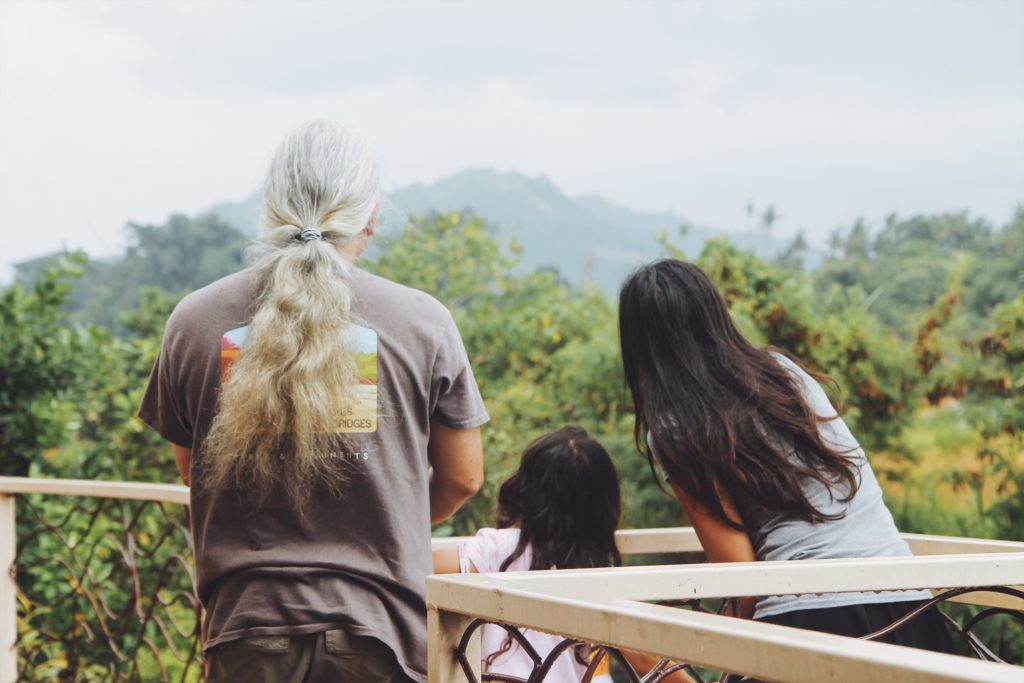
And they’ve got plans to expand their client network to even more hotels, restaurants, grocery shops, and other suppliers.
Hayashi’s existing client network is impressive, but he refuses to go on the record with his his customer lists. “It’s not really my right to just give away their secrets. If they want to say they use my cheese, then yes! Sweet! But I try not to name drop. We just let our cheese speak for itself,” he says.
Pasti Enak seems to be entering the market right at a time when there’s a growing appetite for cheese and other dairy products amongst Indonesians. It also helps that their cheese — unlike most natural cheese found in Bali — is affordable, with most 200-gram wheels running somewhere around IDR50k (US$3.60).
“I think it’s more expats and visitors who eat our cheese, but Indonesians like our cheese. The problem is that all natural cheese is expensive. And they really just don’t have the finances usually to buy all natural cheese, so they buy what they can afford,” says Hayashi.
“I used to eat that processed cheese, because that’s what I could get my hands on. But then Chris bought some cheese. I just tried a little bit, after that the flavor got to me and I started to like it. But before I met Chris, I just ate processed cheese, that’s it,” Hartati chimed in.
—
Pasti Enak’s cheddar is available at Coco Mart, while Frestive in Canggu & Kerobokan, Grand Lucky in Kuta, and Bali Pure in Ubud have limited varieties. The only place that offers the entire range of their cheeses is on Pasti Enak’s online shop here.
